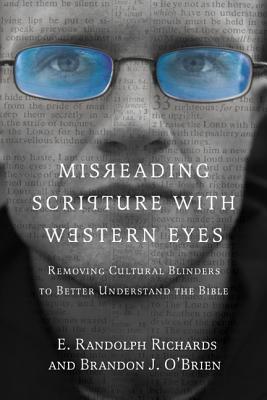 Everything That Goes Unsaid
Everything That Goes Unsaid
Authors: E. Randolph Richards & Brandon O’Brien
There are some parts of the Bible that we read and then glance up from in confusion (the Book of Revelations, for example), but in many places we know the meaning of the text. Or do we? How enmeshed have we become in our own culture, our own time? We see Paul exhort women to dress modestly – and we instantly think of covering skin. But is that what modesty really means? We see passages speaking to us personally, but as far as the macrocosm of humanity, everyone is on their own individual journey, and God sees it that way too, doesn’t He?
Misreading Scripture with Western Eyes was an interesting, short, but highly readable examination of what the Bible actually says in the context of when and where it was written instead of what we (i.e. the West) assume it to mean. For example, an implicit cultural understanding allows us to read between the lines in our own time. Some things don’t have to be said, after all, because they are known. But time itself shows that what a society understands morphs and changes with the evolving culture. Did Paul write to his audience knowing that they already had an unspoken understanding of the basics that allowed him to cut to the heart of things? Of course! But do we, all this time later in this different context, ever stop to think about those unspoken things that were so clear then and are so distant now?
Authors E. Randolph Richards and Brandon J. O’Brien come to the table with humility. If you are looking for a “right” answer, an explanation of how to read everything and exactly what it meant in the context of a time and place, look elsewhere. The purpose of Misreading Scripture is to start the conversation, to encourage a deep dive beyond what we think we understand. And in this, it succeeds.
 The narrative is divided into three parts: Above the Surface, Just Below the Surface, and Deep Below the Surface. Each part gives us a place to start asking questions. For example: what did the individual language itself mean and what context clues do we get? Was the Bible really written towards the individual or towards the eastern approach of a collectivistic society? How have rules and relationships changed, and how does the West look at them today as opposed to the East? Some interesting elements arise, including brief sojourns into a high level eastern culture view. For example – that line about modesty? Well, everyone dressed how we could consider “modest” at the time. It was more about not flaunting your wealth and fine things, not using Christianity and getting together to worship as a way to show off your social status and wealth. It was about spiritual modesty. And reading it, the light bulb goes on. It makes sense! Just a cursory look at what the scriptures say with these “blinders” removed opens us up to a deeper understanding of what is being said.
The narrative is divided into three parts: Above the Surface, Just Below the Surface, and Deep Below the Surface. Each part gives us a place to start asking questions. For example: what did the individual language itself mean and what context clues do we get? Was the Bible really written towards the individual or towards the eastern approach of a collectivistic society? How have rules and relationships changed, and how does the West look at them today as opposed to the East? Some interesting elements arise, including brief sojourns into a high level eastern culture view. For example – that line about modesty? Well, everyone dressed how we could consider “modest” at the time. It was more about not flaunting your wealth and fine things, not using Christianity and getting together to worship as a way to show off your social status and wealth. It was about spiritual modesty. And reading it, the light bulb goes on. It makes sense! Just a cursory look at what the scriptures say with these “blinders” removed opens us up to a deeper understanding of what is being said.
Now yes, I would still love that black and white answer, that assuredness. That in and of itself is a uniquely Western approach, and I am a Western person with all the foibles. Misreading Scripture will not give you answers, per say, but just widen your view beyond what you think you see on the surface. It’s a great place to start the journey and think about the big differences and what they could mean to how we are reading and interpreting the Bible. It certainly whetted my appetite for deeper, more thoughtful readings and further studies. This is a must for all western Christians.
– Frances Carden
Follow my reviews on Twitter at: https://twitter.com/xombie_mistress
Follow my reviews on Facebook at: https://www.facebook.com/FrancesReviews
- Book Vs Movie: The Shining - April 6, 2020
- Thankful For Great Cozy Mysteries - December 13, 2019
- Cozy Mysteries for a Perfect Fall - October 20, 2019

